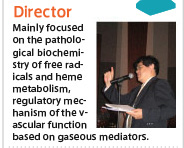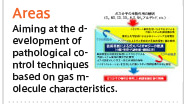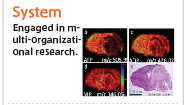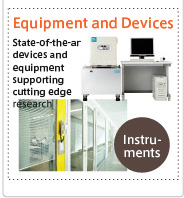Research Areas

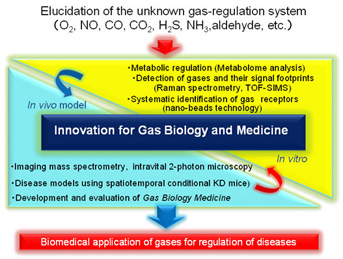 Gas (O2, NO, CO, H2S, CO2, etc.) are known for their longtime use by protozoa in the primitive age as signals to detect changes in the external environment in contemporary mammals they also play important roles for the utilization of biological functions as constituents of the living body as do proteins, lipids and sugars. In this research area, we will conduct complementary macroscopic and microscopic research; such as metabolic system prediction utilizing bio-simulation or analysis of intracellular gas molecule concentration or clarification of the chemical reactions inside the metabolic system including analysis of the molecular structure changes in the binding of gas molecules and molecules that encourage metabolism (enzymes), with the goal of working out the gas molecule-mediated metabolic mechanism.
Further, while utilizing the findings obtained through the analysis of the metabolic mechanism, we will proceed with precise analysis of oxygen or metabolic variations at a local cell level as well as more detailed understanding of the role played by gas molecules in the metabolic function in specific parts of the body aiming to establish the foundation for pathological control technology utilizing the characteristics of gas molecules including realization of artificial control and regulation of the gas molecule environment in specific organs for the further goal of finding clues for applied research such as cancer research or drug metabolism and toxicity mechanism.
Gas (O2, NO, CO, H2S, CO2, etc.) are known for their longtime use by protozoa in the primitive age as signals to detect changes in the external environment in contemporary mammals they also play important roles for the utilization of biological functions as constituents of the living body as do proteins, lipids and sugars. In this research area, we will conduct complementary macroscopic and microscopic research; such as metabolic system prediction utilizing bio-simulation or analysis of intracellular gas molecule concentration or clarification of the chemical reactions inside the metabolic system including analysis of the molecular structure changes in the binding of gas molecules and molecules that encourage metabolism (enzymes), with the goal of working out the gas molecule-mediated metabolic mechanism.
Further, while utilizing the findings obtained through the analysis of the metabolic mechanism, we will proceed with precise analysis of oxygen or metabolic variations at a local cell level as well as more detailed understanding of the role played by gas molecules in the metabolic function in specific parts of the body aiming to establish the foundation for pathological control technology utilizing the characteristics of gas molecules including realization of artificial control and regulation of the gas molecule environment in specific organs for the further goal of finding clues for applied research such as cancer research or drug metabolism and toxicity mechanism. 
Gas are low-weight molecules that are produced in the living body; They characteristically recognize biological macromolecules and bind them in a site-specific manner to regulate their functions. Among such compounds of low-weight gas molecules, there are free oxygen (O2) and nitric oxide (NO) as those are utilized or produced and accepted to effect biological actions, which could include carbon monoxide (CO) that is produced in heme decomposition, carbon dioxide(CO2) that is produced mainly from the TCA cycle, hydrogen sulfide (H2S) that is produced in association with cysteine metabolism, water molecules (H2O) that are discretely present in a hydrophobic microenvironment and capable of forming a hydrogen networking and N2O that intestinal bacteria produce. Comprehensive understanding of the mechanisms by which these molecule groups effect the diverse biological actions in vivo however, lags far behind.
When biological research on NO, the most representative gas mediator for the vascular, neural, and immunological systems was at its peak, the ingenious adjustment of functions of various biological molecules by plural gas molecules other than free oxygen inside the body was inconceivable.
The director and others have been the first in the world to report the molecular mechanism of the CO production in the liver and vasorelaxant (J Clin Invest 93:1995, J Clin Invest 96: 1998). They reported pioneering findings in the relevant domains that the biological actions of heme oxygenase is generated by the elimination of reactive oxygen species by bilirubin that is produced by another product biliverdin (Circ Res 85: 1999), or that CO biphasically controls cellular functions depending on the NO concentration based on the interaction with soluble guanylate cyclase(Circ Res 89: 2001). Recently, it has been revealed in the carotid body glomus cell that heme oxygenase-2 reduces the probability for open channel of Ca
2+
dependent K
+
and depolarizes cells by sensing hypoxia and reducing CO generation (Science 2004). The identity of the molecules that directly accept gas molecules such as CO has been obscure, and the quest for their identity has posed the biggest obstacle to the promotion of research in the relevant areas together with the absence of methodology for systematic analysis of their roles in metabolic control.
※Gas molecules

One thing indispensable to overcome the aforementioned obstacle is comprehensive understanding using metabolome analysis technology, for the behavior of the metabolic system in cells and organs through the gas molecule response. Next is the development of nano-technology based systematic seeking techniques for target molecules and new vibrational spectroscopic imaging technology, which could bring major breakthroughs in the revelation of the thus far difficult to analyze gas molecule response mechanism and its dynamics in the body, as an index the former uses the interaction with metal-containing complexes as an important molecular target that gas molecules directly interact with. Furthermore, it is hoped that interdisciplinary and combined research would realize the goals by gathering together knowledge from various disciplines such as life information science, where mass spectrometric techniques enabling the comprehensive and quantitative understanding of the cellular and tissue metabolic variation, and biometric data gathering based on the bio-imaging technology are combined, biophysical chemistry utilizing analytical techniques for the physicochemical structure of the complex of gas molecules and bio-polymers, as well as biometric techniques for gas molecule behaviors based on the applied laser techniques, and pathological medical chemistry employing genetically modified animals. In other words, this research will seek its goal by gathering together state-of-the-art technologies and researchers from different disciplines to create a new research area.
This project intends to clarify the mechanism of the production, acceptance, and distribution of gas molecules and eventually apply their characteristics to Medicine.
※Technologies used in the project

To overcome numerous challenges and propel the gas biology research, correct understanding from a comprehensive and systematic perspective of "When, Where, How" gas molecules in the body work. We assume that the temporal-spatial dynamic state of gas molecules (localization or local concentration) will be clearly verified through the development of the imaging techniques based on a functional probe sensitive to the gas molecule. In the course of proceeding with gas biology, it will be of very great significance to understand where gas molecules emerge at the organ level or inside the cells if a living body is exposed to stress, which, in other words, establishes a system that captures the local dynamic states of gas molecules in real time. Next, the base technology needs to be structured to clarify by which molecules the gas molecules are accepted and subsequently passed on to the downstream signals by which mechanism. This project will develop the novel technologies listed below through the use of the strong interactions with the metal-containing complex as the basis for gas molecules to directly interact with bio-polymers thus aspiring to a breakthrough that no single university research center could achieve.
a ) Nano technology-based systematic search for target molecules
b ) Development of a mass spectrometry imaging technology that enables the analysis of characteristics of cell-specific metabolic systems using living cells or frozen tissue samples, without destroying the anatomical structure.
c ) Development of a vibrational spectroscopic bioimaging technology that enables detection of gas molecules and low-molecular compounds based on the metal nano-particle array technique using gold, silver and the like.




















